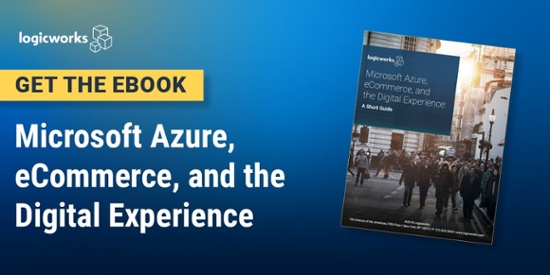Retailers are building more personal, differentiated experiences for customers online and in stores. In order to support these new applications, they need a flexible infrastructure platform and powerful data services — and as a result, are increasingly turning towards Microsoft Azure.
Over the past year, the team at Logicworks has seen a surge of interest in migrating applications to Microsoft Azure, particularly for retailers. So we sat down with Adam Burke, the Director of Partner Development on the Datacenter Optimization team at Microsoft. Adam helps customers and partners understand how to migrate to the Azure cloud. Below is a selection from our interview.
What’s your role at Microsoft, and how is it changing in response to customer demand?
I help customers and partners manage the transition to Azure — both helping them understand the business value of Azure and choose the right partner for Azure migration and management. Increasingly, we’ve had more customers telling us that they no longer want to manage infrastructure, or no longer want to be in the datacenter business. Instead, they want to transition all of their infrastructure and assets to Azure.
What is the main driver of Azure adoption?
We see many customers start with a key workload or a key solution. Many times it is either a Private Cloud environment that they’re looking to move over, or it’s older infrastructure that they need to refresh. Usually companies don’t want to allocate funding the “old way”, by pumping more dollars into their on-premises investments.
But beyond just replacing on-premises infrastructure with Azure, companies are looking to take advantage of all the new capabilities of the cloud. It’s the digital transformation that customers are going through right now that is a key driver of Azure adoption.
Why are retailers choosing Microsoft Azure?
Increasingly retailers are working to digitally transform their business in order to stay relevant and competitive. So I think at a top level, digital transformation is driving adoption. You have benefits at the infrastructure level of just being able to scale up and scale down during back to school or the holiday season — peak times for retailers — without having to always run that same constant level of infrastructure to meet peak demand.
Retailers are also taking advantage of the new trends around machine learning to better leverage the data that they have. Data is a key currency for business to make sure they’re best positioning their offerings to customers. This is key in terms of looking at two things: modernizing what they have, but then also figuring out how to move forward with their digital transformation and how to take their capabilities to the next level using cloud-native technologies. Those capabilities just don’t exist on-premises, or would take huge amounts of investment to deploy them on-premises.
When retailers migrate to Azure, they’re benefiting from business agility. You can stand up resources in another continent at a moment’s notice, or right-size your infrastructure quickly due to a holiday promotion that takes off — all of these are benefits that you don’t get in the on-premises world.
We’re also seeing retailers choose to partner with Microsoft, because they see us as a true business enabler vs. as a competitor, which is how other hyperscale providers could be viewed.
Why do retailers choose to build custom applications on Azure over a 3rd party SaaS solution?
It comes down to the level of customization and control that you get when you own the infrastructure vs. SaaS. Certain SaaS solutions can be great when you just want to consume a service and you don’t have significant constraints on how you consume that offering. But a lot of times I’ll hear from partners and customers that they’ve looked at a SaaS offering, but they need certain types of reporting, or a particular customization or capability that the SaaS offering doesn’t offer. There’s still a huge amount of value with having that depth of control that Azure can offer. This is especially true if it revolves around their customer data and the ability to maximize the insights they’re getting out of that data.
How does the Azure migration process usually occur?
Most often migrations occur in waves. Customers frequently move 10-15% of their infrastructure to start, and then based on the success, come back and migrate incrementally to Azure. They take the approach of a phased migration process building on their initial success. At other times, it’s proving out the model and showing the benefits and value of running that infrastructure in Azure, and then iterating on that. That allows customers to build internal confidence to perform those migrations at a larger scale.
Lift and shift migration can be good to get you into Azure, but at some point it makes sense to refactor your application to take advantage of cloud-native services. For instance, you may want to move your databases into Azure and leverage SQL running on a VM at first, but at some point, it’s probably worth considering Azure SQL. These platform-as-a-service capabilities can ensure that your application is more elastic, as well as potentially reduce the total cost of ownership for managing that application.
Do retail companies generally migrate on their own, or with a partner?
When customers ask me this question, I always recommend working with a partner to drive these migrations. There are two reasons that I recommend this.
One reason is that there is a huge cost around migration. Sometimes that’s why customers say they want to do it on their own rather than going to a partner. But if you look at the cost of a good migration vs. the cost of a poor migration or the cost of doing it incorrectly — I would argue that the risk of failure far outweighs the cost of having a trusted advisor with you throughout the process to make sure that things go as smoothly as possible.
The second reason is that if you don’t have that partner for the migration, you’re going to be limited in terms of what you know and how to do things in Azure. For example, automation in the cloud is critical, especially for retail. Working with a partner that knows how to do automation properly and can tell you how to auto scale resources could have a very significant impact on your total cost of that solution running in the cloud. That’s where strong Azure partners can help you by not only by reducing downtime and smoothing the path to a migration, but also by reducing the cost of cloud consumption and helping you take advantage of new capabilities in the cloud. In the case of retail, there can be huge cost savings that come from leveraging the full capabilities of the cloud.
How secure is Microsoft Azure for retailers’ customer data?
A key benefit of being a hyperscale cloud provider is the investments we can make around security. Both how we build and how we run the platform. But you can have all the physical security in the world from an infrastructure standpoint, but if the infrastructure isn’t managed or orchestrated properly, then all your security investments are for naught. So from a security standpoint, having an experienced Managed Service Provider plus Azure is the best of both worlds to ensure that infrastructure remains protected and you’re taking all of the precautions possible to avoid being breached.
Thanks Adam for talking with us! If you have any questions about Logicworks’ Managed Azure Services, please contact us or visit our website.


